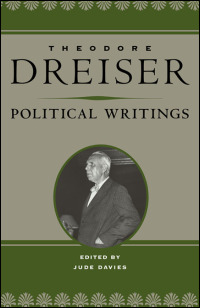 A photograph* among the papers of the novelist Theodore Dreiser shows him in November 1931, during a visit to the coal mining area of Harlan in Kentucky. The seated Dreiser looks every inch the New York sophisticate, in a pale suit, white socks and white shirt, bow-tie, and shoes polished to a dull shine. His comfortable, even luxurious appearance contrasts with the two other people visible in the photo, who sit and gaze sidelong at Dreiser as he talks. Nearest to him is an African American woman, arms folded, who appears slightly uncomfortable. Perhaps she is cold, in her cheap-looking cotton dress. Next to her is a white man of pinched, aquiline features, his shirt unbuttoned at the neck, his dark trousers and worn shoes a marked contrast to Dreiser’s finery. The man’s hands are visibly darkened and calloused with hard labor.
A photograph* among the papers of the novelist Theodore Dreiser shows him in November 1931, during a visit to the coal mining area of Harlan in Kentucky. The seated Dreiser looks every inch the New York sophisticate, in a pale suit, white socks and white shirt, bow-tie, and shoes polished to a dull shine. His comfortable, even luxurious appearance contrasts with the two other people visible in the photo, who sit and gaze sidelong at Dreiser as he talks. Nearest to him is an African American woman, arms folded, who appears slightly uncomfortable. Perhaps she is cold, in her cheap-looking cotton dress. Next to her is a white man of pinched, aquiline features, his shirt unbuttoned at the neck, his dark trousers and worn shoes a marked contrast to Dreiser’s finery. The man’s hands are visibly darkened and calloused with hard labor.
These contrasts of class status, and between urban and rural, create a scene redolent of Dreiser’s novels such as Sister Carrie. His ostentatious dress certainly combines elements of his protagonists Carrie Meeber and George Hurstwood — but his presence in Kentucky was a political, not a literary response to the Great Depression. He was there to investigate claims that the local coal-mine owners had instituted a reign of terror to put down labor unrest, evicting and intimidating miners, and dynamiting their soup kitchens, with the active or tacit support of local law enforcement, courts, and newspapers. A few years later, these charges would be substantiated by a Congressional investigative committee, but in 1931 the miners’ cause was an unpopular one, supported by few outside the Communist Party and the non-aligned left.
This was but one example in a succession of Dreiser’s political engagements chronicled in detail for the first time in my edition of his Political Writings. These included Populism and Progressivism around the turn of the nineteenth century, Greenwich Village radicalism in the 1910s and 1920s, Communism and other left-wing causes, and the Technocracy movement in the 1930s, anti-war agitation, and the internationalist “One World” movement in the aftermath of World War II. None of these ever made Dreiser popular, and it is probable that his association with Communism exerted a seriously detrimental effect on his reputation as a novelist for decades. Add to this Dreiser’s lack of a coherent political position, his tendency to exaggerate, and the remnants of the small-town prejudices of his nineteenth-century mid Western upbringing, and it is small wonder that literary critics still tend to dismiss or disregard Dreiser’s political activism.
Yet it seems to me that the Harlan photo crystallises something valuable about Dreiser’s political quest. Messy but intriguing, Dreiser’s political trajectory eschews notions of human solidarity predicated on group identities such as class, ‘race,’ and even national identity. For him, even a basic sense of common humanity can never be taken for granted, but instead must be forged across the multitudinous differences that compose individuals. It is this that makes Dreiser’s politics strikingly resonant with our post identity politics, post colonial, post communist, post 9/11 age. For Dreiser, difference is a given — his unfinished political quest is to generate a sense of solidarity that can bridge it.
*From the Theodore Dreiser Papers at the University of Pennsylvania Library.
*****
Jude Davies is a professor of American literature and culture at the University of Winchester and the editor of Theodore Dreiser’s Political Writings.
